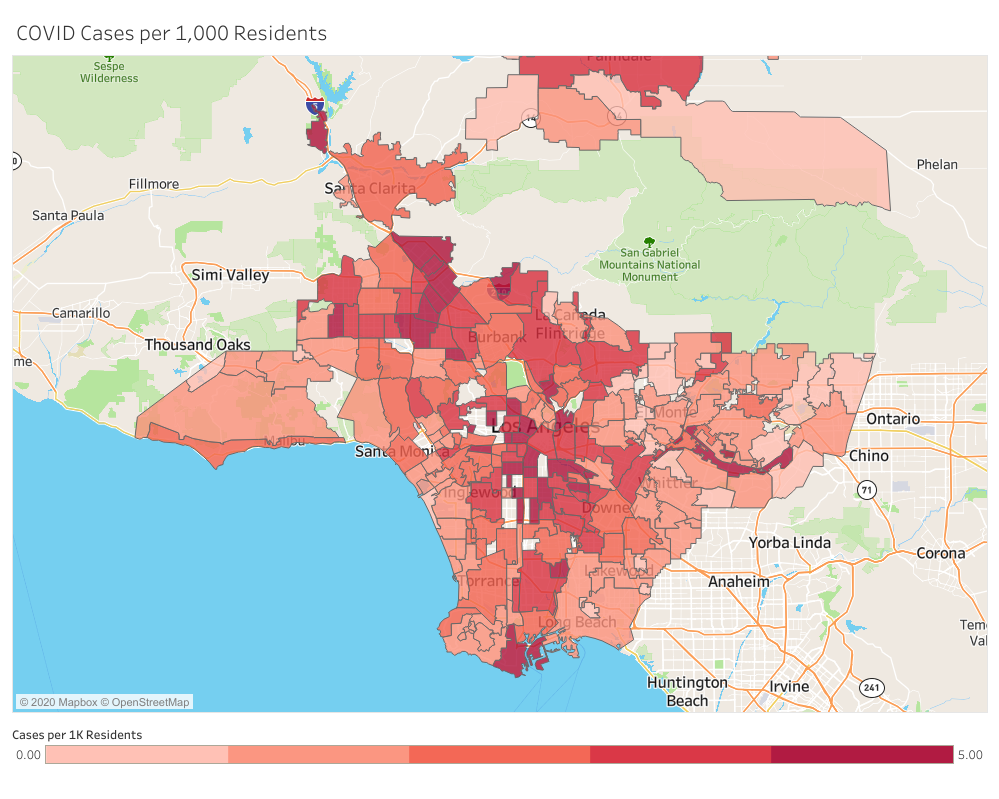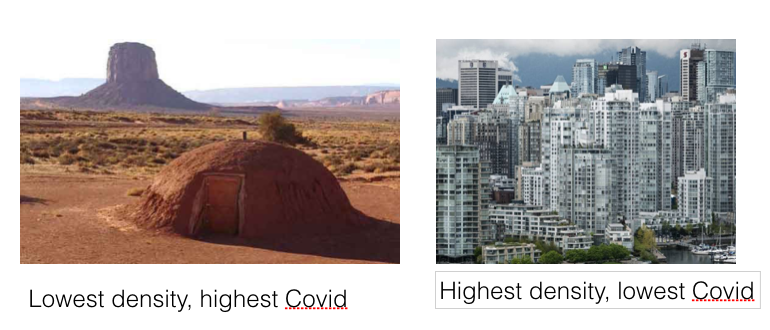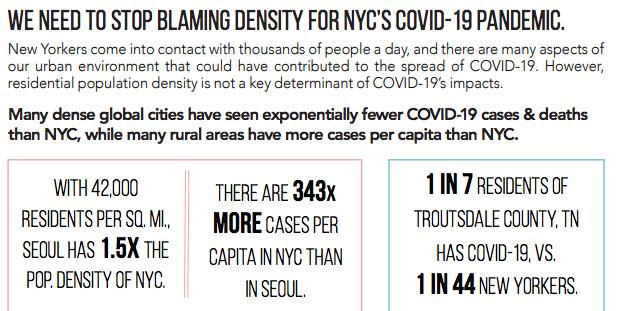What City Observatory did this week
1. LA Covid correlates with overcrowding and poverty, not density. City Observatory is pleased to publish a guest analysis and commentary from Abundant Housing LA’s Anthony Dedousis. Los Angeles County has released detailed geographic data on the incidence of the Covid-19 pandemic, and Anthony offers a series of charts, maps and a regression analysis that explore the common characteristics that are related to the the outbreak. He finds that poverty and housing overcrowding are positively correlated with the prevalence of Covid-19 cases within LA County. But like other studies that have looked at neighborhood geographies, he finds essentially no correlation between the housing density and Covid-19 cases.
2. City Beat: Pushing back on the claim that a city is “uniquely vulnerable” to the pandemic. We look closely at a recent Portland Oregonian article claiming that Multnomah County, home Portland, is somehow “uniquely vulnerable” to the Coronavirus, because of its size, diversity and density. While its clear than the area’s large population and greater diversity than the rest of the state makes the hiring of culturally adept contact tracers a larger and somewhat more complex task, there’s little to indicate Portland’s underlying problem is worse or different than elsewhere in the state. Multnomah County’s rate of cases per capita is about half that of the Salem area, and is only slightly higher than in adjacent suburban Washington County. Most egregious, the article asserts (without any evidence) that Portland’s density makes Covid-19 worse.
Must read
1. Henry Grabar, writing at Slate, warns cities not to repeat their errors of the past in kowtowing to the automobile. Sure, we have some work to do to get transit systems back on their feet in a post-Covid world, but cars aren’t the solution:
Another carpocalypse is looming as coronavirus shutdowns ease. Traffic is rebounding but mass transit is not—and won’t for some time, if the experience of cities in Asia and Europe are any guide. Once again, city leaders will be under enormous pressure to accommodate drivers.
We’ve been down this road before: For most of the 20th century, planners were convinced that faster, bigger roads and ample free parking would halt “decentralization” and save the centers where people worked. The results speak for themselves: Cities with overgrown highway networks and plenty of parking are, contrary to theory, now the ones that few people want to come to. Cities cannot beat suburbs at their own game. But they can destroy themselves in the process.
2. The prescription for avoiding the next pandemic (and saving the planet) is to clean up urban transportation. In an Op-Ed for the Boston Globe, Dr. Gaurab Basu, makes an explicit connection between the coronavirus, climate change and the deeply unfair characteristics of our current transportation system. Low income people are not only poorly served by our auto-dominated transport system and feeble mass transit, they also bear the brunt of its negative health and environmental effects. Low income communities, are, for example, disproportionately exposed to fine particulates from vehicle exhaust and tire wear, and the respiratory problems that creates make them more susceptible to Covid-19: As Dr. Basu eloquently puts it:
My oath as a doctor is to first do no harm. But our transportation system does active harm to my patients by polluting the air and destabilizing the climate. We need to stop describing the big problems of our time, and instead act with conviction to solve them.
3. Coronavirus is not a reason to abandon cities. Aaaron Gordon writes at Vice, in a post-covid world public policy will be critical to the future of cities. While (as noted elsewhere in today’s Week Observed) the density argument is essentially a red herring, the pandemic itself creates an unsettled and changeable political environment in which we’ll be seeking solutions that give us an assurance that we won’t be susceptible to future breakouts. For some, that’s framed as an “escape to the suburbs.” The danger is that, as in the past, public policy will be tilted in a way that hurts cities. Gordon notes:
Just as the widespread abandonment of American cities in the 20th century was the result of very clear policy choices made at all levels of government that incentivized people on nearly every level to buy a house in the suburbs, so too will whatever happens with American cities next be the result of people responding to incentives put before them, not a vast array of individual choices about how they feel about density. Much of this rests on the federal government’s shoulders, but cities and states have leeway to determine their own futures.
New Knowledge
While much of our attention is now focused–appropriately–on working to reduce the number of new cases daily, cities everywhere will want to do the kind of careful analytical work presented here to help give their citizens and government officials a clearer idea of what factors do—and do not—increase a city’s vulnerability to pandemics.
Citizens Housing and Planning Council, Density and Covid-19 in New York, May 2020,
https://chpcny.org/wp-content/uploads/2020/05/CHPC-Density-COVID19-in-NYC.pdf
In the News
Strong Towns republished our commentary, Postcards from the Edges, noting that the Navajo Nation, with some of the most sparsely inhabited areas of the country has a higher rate of Covid-19 cases per capita than New York City.
The Hillsboro (Ohio) Times-Gazette, quotes City Observatory Director Joe Cortright’s commentary, “Density isn’t Destiny” in its article discussing the pandemic.




